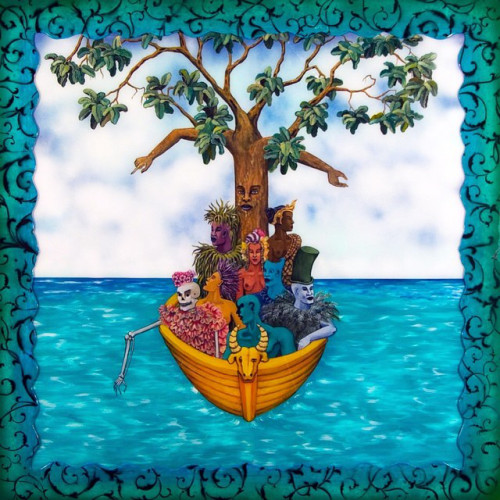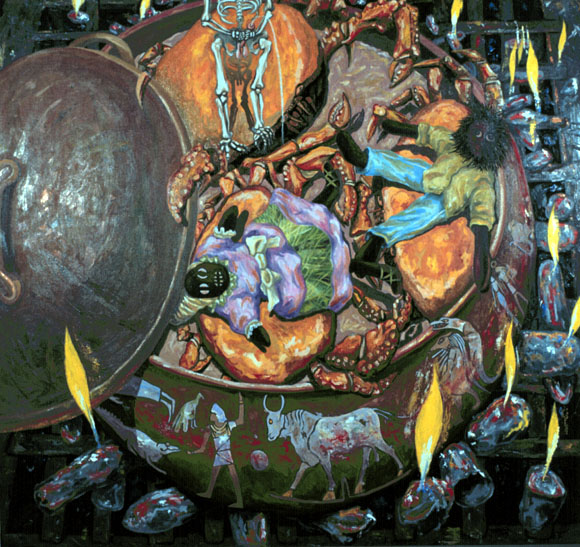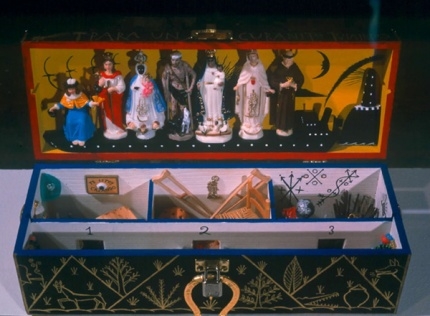José Bedia, Edourad Duval-Carrié and Keith Morrison are three Caribbean artists who now reside in the United States. Morrison moved from Jamaica to the United States in 1959 to enter college and has remained here since. He is currently dean of the College of Creative Arts at San Francisco State University. Duval-Carrié’s family moved from Haiti to Puerto Rico when he was a child. He attended high school in New York and University in Canada. He now has homes in Miami and Haiti. José Bedia moved with is wife and son from Cuba to Mexico in 1990 and then to Miami in 1993.

Edouard Duval-Carrie: “”Milocan ou La Migration Des Espirts: La Traversee”
Oil on canvas 95 X 65″ 1996
Conceptions of an artist’s home or national identity are becoming increasingly variable. Many artists who now live in the United States reveal in their work layered identities. So do the African, Caribbean and Asian artists living and working in London, and the Pacific, Caribbean and African artists living and working in Paris. This swelling group also includes the many artists who are refugees, self-designated or otherwise.
We are solidly in the era of the transnational artist. What is so interesting about Morrison, Edourad Duval-Carrié and Bedia is that their work speaks to issues of their own cultural identity while simultaneously invoking broader issues of migration and the fragile contemporary human condition.
Each story Keith Morrison tells has a Jamaican element – a personal anecdote about his life in a country and a culture that thrives on stories and where storytelling is a celebrated art form. In Jamaica there is a tradition which produces plays and “pantomime” full of words and raucous laughter.1
Morrison often refers to his own “personal lexicon of myths and images,” and no doubt his Jamaican roots have a lot to do with the creations. Some of his imagery also has parallels to other Caribbean cultures. Although Morrison contends “I don’t try to make it Jamaican; I don’t even think about Jamaica, he does acknowledge that many of the images are born of very basic experiences in African diasporic culture.
Death is a recurring theme in in a series that was exhibited at the Bomani Gallery in San Francisco in spring 1996. As Morrison was explaining his fascination with graves, I suggested that many of the themes he works with provide a type of exorcism, a way to recall and come to terms with his Jamaican youth.
He often accompanied elderly relatives to funerals. In Jamaica funerals are a grand affair, an occasion not only to honor those who have passed on but also to meet with seldom seen relatives and friends.
Morrison has written: “In the Caribbean a funeral is a wonderful pageantry of religion and supernatural spirits, a place where reality and fantasy coexists.” Remembering the festive occasion that accompanied his own mother’s funeral, he says with a broad smile, “Basically, they launched her.”
A Funeral Fit for Egypt is a powerful summary of Caribbean and African American humor. Here is the artist laughing at himself and his people. Yet his laughter is filled with respect and perhaps some nostalgia. Morrison spent is youth participating in complex religious events (some on the sly, away from family who would have disapproved), yet today he considers himself one of the least religious people he knows. He fills his paintings with biblical references which perhaps should be regarded as literary rather than religious.
Morrison is well-versed in African American literature, and many of his paintings, such as A Funeral Fit for Egypt, comment on certain aspects of it. Throughout the history of the African diaspora important thinkers have used the image of Egypt to affirm black creativity and strength. Egypt as a conceptual force and historical fact is at the core of both formal religion, such as Rastafarianism, and popular culture.
In A Funeral Fit for Egypt icons of Egyptian tomb paintings adorn the ravaged buildings and tombstones. It is a grand celebration of death. Yet in the center of the painting, above the terrestrial tale, a golden trumpet is carried aloft in the talons of a green feathered tropical bird. I cannot help but think of references to Gabriel merging references to Miles and Dizzy. I am even more tempted to speculate that the lush tropical bird and the golden horn provide a relief, an image of joy in the gritty decomposed city. Morrison is an urbane man yet his paintings depict the disintegration of the city and city life.

Keith Morrison: “Crabs in a Pot”
oil on canvas, ” 60 X 64,” 1994
The artist also makes satirical reference to things Egyptian. Perhaps he is commenting on the fad for Egyptian images and replicas of artifacts and the integral position of Egypt in Afrocentric philosophy. In the painting Crabs in a Pot a frieze of Egyptian-styled figures and animals decorate the circumference of a clay pot in which dolls, a skeleton and crabs are cooked. This imagery ominously refers to the African American, “Crabs in a Barrel” proverb. The maxim comes from Booker T. Washington’s 1901 autobiography, Up from Slavery. According to the artist, “The pot is sometimes my tableau where the futility of human turmoil and self-destruction plays itself out, like burning bodies clawing over one another in a death filled cauldron.”
It is tempting to compare Morrison’s art with Haitian painting. Most Haitian paintings tell stories, and, to the uninitiated, the stories may appear to be similar. Both contain references to death, to graveyards, to skeletons. But there is a big difference. Haitian paintings usually tell similar stories of the Lwa, the gods of the Vodou religion. Haitian iconography is for the most part determined by Vodou or by Haitian history and therein lies the challenge for younger contemporary Haitian artists. They must innovate on these standardized narratives. That is why recent work by the Haitian painter Edourad Duval-Carrié is so potent. He has created a very personal, stylized version of the basic iconography of Vodou, metamorphosing the Iwa into haunting stylized actors.
Duval-Carrié creates complicated dramas that are as full and nuanced as Morrison’s, although their stylistic strategies are quite different. While Morrison’s canvases are packed with figures, actions, and landscape, Duval-Carrié’s are almost stark and static, even though the figures are deliberately detailed and dramatic.
Both artists use the lush Caribbean vegetation to assist in claiming place and moment, even though one is not quite sure which moment. For example, Duval-Carrié’s figures are often dressed in the style of 18th century France, recalling the period of the French Revolution. And at the same time this style recalls the dress of the French colonials in Saint Dominique, soon to be renamed Haiti after the successful fight for independence from France (1772-1804). Sometimes Duval-Carrié even uses the dress of the contemporary elite of Haiti and Miami. And then he dresses the Iwa in these same fashionable clothes, forcing the viewer to closely scrutinize the scene to figure out who is “real” and who is spirit.
This approach is quite clear in a recent series of paintings, “Milocan ou La Migration Des Espirts.2 The first panel is Le Depart (The Departed). Naked humans are led away in chains, but they are painted in non-human colors, bright pinks, oranges, and turquoise. This is the first hint we get that these “humans” may in fact also be something else, perhaps even the African spirits that make up the core of the Vodou religion. These naked souls are chained to others, clothed and fancily dressed. One has a skeletal face and is wearing a jacket adorned with what may be African style amulets – little packets of power that also will be taken to the Americas with the captives. Here Duval-Carrié is alerting us to the African sources of the Vodou religion and to the special esteem that is due the ancestors of the people of the African Diaspora. In the background a tree with many branches and a human-like face in its trunk watches over the scene, and then we realize that this tree too wears an iron collar and is also a prisoner.
The second panel La Traverse (The Crossing) obviously references the middle passage. The group of spirits are seated in a row boat, adrift on a blue ocean. The “tree” accompanies them in the back of the boat and two and two of the branches have metamorphosed into human limbs and hands. Duval-Carrié has placed the tree in the absolute center of the composition, a device that he has used frequently in other paintings. This is a reference to the tree trunk-like center pole of Vodou, the “Poteau mitan” which the Lwa descend during a Vodou service. In this narrative the strength and spirituality of Africa are being transported to the Americas, albeit under horrendous circumstances.
Duval-Carrié has developed a singular style that reflects a poetry of ambiguity. His figures are flat, graphic and starkly painted. They are deliberately posed, as if frozen in a particular scene, a part of a narrative. We see them in rich detail, can describe them in in the minute detail that Duval-Carrié offers, yet we cannot be sure if we are reading the narrative correctly. These bizarre, lushly colored actors perform a drama that continues and repeats, much like the history of Haiti itself.
In 1983, José Bedia was initiated into the Afro-Cuban religion Palo Monte. During this time Bedia began working with a living religion and the people who practice it.
For some artists the ‘popular culture” of non-European religions experience provides nothing more than certain elements to be manipulated, thus relegating religious belief to a marginalized position within artistic production. But for Bedia, his religion and his collaboration with other religious leaders and artists provide a foundation and a wellspring of aesthetic energy. While living in Cuba he was an active participant in all events at the house of his Palo Monte Tata, or initiating sponsor. In his art Bedia reveals the multiple contexts of his own life and the parallel layering (hybridity) of contemporary society.
Although known for his signature hand-painted large wall figures and accompanying floor installations, José Bedia’s fall 1997exhibition at the George A. Adams Gallery, NYC, consisted of ten carved and painted object-ensembles, made from light weight pine, mounted on the walls, and two handcrafted boxes resting on pedestals. In these new pieces there is a condensing of narrative. Bedia references the use of miniature mass-produced figurines and religious representations commonly associated with children’s toys and religious objects. These constructions exhibit finely painted figures in stark outlines, juxtaposed with a recurring depiction of specific trees, plants, animals, and objects, such as knives or machetes, used in religious practice.
In these pieces Bedia combined religious references with images of imagination and travel. Many of the objects are vehicles of physical transportation, like boats and trucks. Here the metaphor for Bedia’s own life is direct, for the reference is to both physical and metaphysical movement. Both of these references are autobiographical, for, as self-designated refugees, Bedia and his family have moved and Bedia himself has been moved by his religious practice.
In a similar vein, the two small boxes hint at migration and faith, which is always portable. Para un Cubanito Viajero (For a Wandering Cuban) is a hand-made toolbox constructed as a portable altar, consisting of three altar-like rooms which pay homage to the three major Afro-Cuban faiths: Palo Monte, Santeria, and Espirtismo. Placed on the open lid are miniature statues of the most important gods of Afro-Cuban faith. Although each is represented by a Catholic saint, all religious Cubans know that each saint is cross-referenced with an African deity. For example, the Brown virgin is the Virgen de la Caridad de Cobre, the patron saint of Cuba, who is celebrated as the Afro-Cuban oricha Ochun. Painted in the back of the other box is a swimmer positioned between two miniature wood ships, partially submerged in the water. One boat is named “Cuba,” the other “Habana,” and both are sinking. A man on the inner tube is stranded in the vast ocean that encompasses and sinks the boat. This composition is a reference to the balseros – the Cuban refugees who flee on inner tubes, with perhaps only their faith to sustain them.

Jose Bedia: “Para un Cubanito Viajero,” acrylic, found objects, wood
14 1/2″ X 16 3/4″ X 9″ 1997
These objects are deceptive, for Bedia has constructed miniaturized environments reminiscent of scenes that children build. Bedia worked with his son Pepito to create these objects. But their content and subject matter belie their form, for serious content merges with brightly painted toy-like objects. A related painting, Al Limite Possible (At the Extreme Edge, 1996), has a miniature inner tube attached to the canvas, with the rope emerging from a painted depiction of Havana architecture set along the top perimeter of the canvas. In the blue ocean below, Bedia has painted two eyes, one crying and one pierced with a sword. The latter references an oath taken by religious adepts who swear to keep the faith. The crying eye again reminds us of the travails of the immigrant. During his years of travel the educated tourist José Bedia has seen and collected crafts, but he knows well that these objects cannot substitute for the experience, tangible and heartfelt, of the immigrant and believer.
José Bedia, Edourad Duval-Carrié and Keith Morrison present us with actors in tropical/lush yet anguishing tales of layered histories. Here is the emergence of a new cultural condition, steeped in respect for the past and frightened by the violence of the present. These contemporary artists are creating transcultural art that participates in and reflects the cultural hybridity of the late 20th century. It is as through their art that we get hints at how they position themselves in a complicated process of cultural exchange and how they express transcultural citizenship.
Edourad Duval-Carrié and Keith Morrison 1 Satirical drama in play and in song is a longtime Caribbean tradition. In Jamaica comics have performed “pantomime” for decades. In the 1950’s Morrison, while still a youngster, worked as an apprentice stage designer and, later, as TV sound effects technician with some of the great Jamaican comedians, Ranny Williams, Louise Bennett, and Charles Hyatt.
2 “Milocan” is a Vodou word that refers to a spirit which is a collective entity. Its veve (sacred drawings) is composed of parts of the veve of many different Iwa.
Judith Bettelheim, Ph.D., is the author of many catalogues and books, including Afrocuba: Works on Paper, 1968-2003; Transcultural Pilgrim: Three Decades of Work by Jose Bedia; Cuban Festivals: Century of Afro-Cuban Culture; and, with John Nunley, Caribbean Festival Art.
